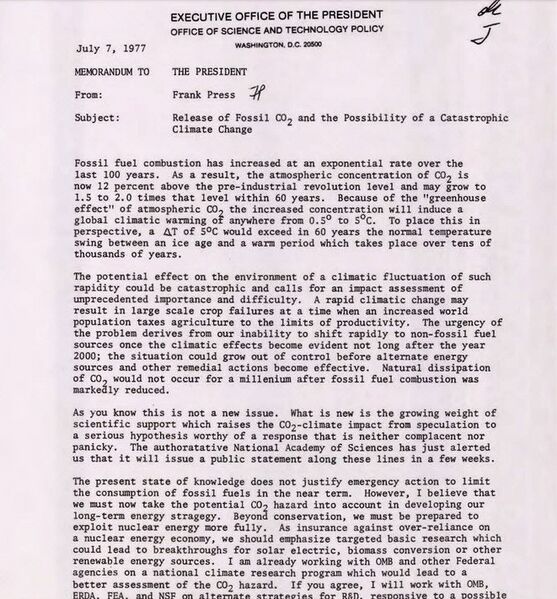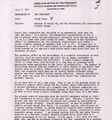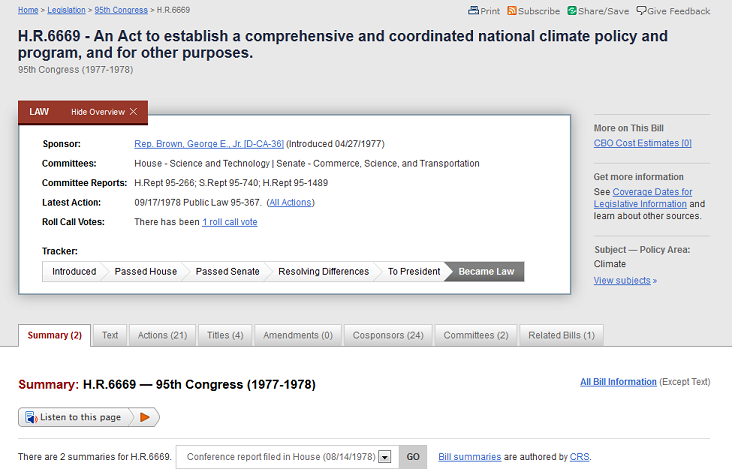File:1977 from the Office of Science and Technology Policy.jpg

Original file (661 × 711 pixels, file size: 177 KB, MIME type: image/jpeg)
Courtesy of the Jimmy Carter Presidential Library (public domain)
Office of Science and Technology Policy
In 1976, Congress established the White House Office of Science and Technology Policy (OSTP) to provide the President and Executive Office of the President with advice on scientific, engineering, and technological aspects of the economy, national security, homeland security, health, foreign relations, and the environment...
○ ○ ○ ○ ○ ○ ○ ○ ○
"My friend George"
GreenPolicy360 Siterunner / SJS
George Brown was instrumental in proposing and establishing of the U.S. Office of Science and Technology Policy in 1976.
With Congressman Brown's support, the new Office sent the first fossil fuels/CO2/climate change warning letter to President Carter in 1977. This can now be seen as a profound initial warning of the critical, and escalating dangers of climate change.
George Brown proposed the first U.S. national climate change legislation, the National Climate Program Act, drafted the legislation, and shepherded its passage back in 1978.
In his rumpled suits and quiet way George moved to form coalitions few thought could be formed and garnered support for the first set of U.S. Congressional acts that served as foundation legislation for decades of green progress.
Congressman Brown Out in Front of Climate Action
George was looking forward to the 21st century and especially to the challenge of nuclear non-proliferation, his concern for decades.
George was a visionary, an engineer, a military veteran who opposed the disastrous Vietnam war, and a leader in Congress who led from California in shaping the modern environmental movement.
George looked at national security, and global security, in ways few in the U.S. Congress did.
In the 1970s he was among the the first voices speaking of environmental security and led effortsto recognize the threat of climate change and golobal warming.
George Brown proposed and drafted the legislation of the first U.S. National Climate Program and shepherded its passage in 1978.
The National Climate Program Act, Public Law 95-367
- The first federal program established to study and assess scientifically the issues and risks of human-caused climate change.
At the Beginning of U.S. Science on Global Warming, Strategies & Planning
Energy and Climate Report, 1977, National Academy of Sciences / 175 pp. / PDF via GreenPolicy360
1978, the First Climate Actions
National Climate Program Act, Public Law 95-367
In 1979 came the first follow-on National Science Academy report. This study and report of national scientists was prescient and accurate in its global warming predictions.
○
In his rumpled suits and quiet way George E. Brown moved to form coalitions few thought could be formed and garnered support for the first set of U.S. Congressional acts that served as foundation legislation for decades of green progress.
The First Earth Day: Personal Memories by Steven Schmidt of George's Role
Congressman Brown's work advanced environmental air quality and clean air legislation. He introduced the nation's first bill to ban lead in gasoline and was at the forefront of the Clean Air Act. He attacked Los Angeles smog, some of the worst air quality of any city in the world at the time and the air standards that came out of California became models worldwide. He succeeded in clean air and water efforts, though rarely given credit given his quiet approach to accomplishing big picture goals.
George was a key player in legislation founding the Environmental Protection Agency.
As the LA Times noted (without pomp or circumstance) in George's obituary in 1999: "He championed the creation of the federal Environmental Protection Agency". The creation of the EPA was in many ways Congressman George Brown's vision achieved..."
The founding of the EPA was based on new realizations of science and the environment. The vision of the "Whole Earth" that began with unprecedented Apollo photos on the cover of Life magazine in January 1969 led to a coming together of education, students 'teach-ins', scientific space missions studying earth systems for the first time, and popular demands for environmental protections.
A leader and a chairperson on the House science committee for over 30 years, George legislatively engineered an array of science efforts, including one that greens look to as prescient -- climate science.
In His Time, a Visionary Leader in Science
- Advancing Historic Environmental Achievements
A generation of environmental policies, programs & law
~
George E. Brown, Jr. was widely known as the leading statesman and advocate for science, engineering and technology policy in the United States Congress. George Brown was a member of the House of Representatives from California for more than 35 years. During his tenure he rose to the Chairmanship of what is now the House Committee on Science, Space & Technology and was one of the nation’s most ardent supporters of federal research.
~
File history
Click on a date/time to view the file as it appeared at that time.
| Date/Time | Thumbnail | Dimensions | User | Comment | |
|---|---|---|---|---|---|
| current | 14:53, 1 January 2021 |  | 661 × 711 (177 KB) | Siterunner (talk | contribs) |
You cannot overwrite this file.
File usage
The following 9 pages use this file:
- Air Pollution
- Air Quality
- Anthropocene
- Atmosphere
- Atmospheric Science
- Biodiversity
- Citizen Science
- Clean Air
- Clean Water
- Climate Change
- Climate Policy
- Earth
- Earth360
- EarthPOV
- Earth Day
- Earth Imaging
- Earth Observations
- Earth Science
- Earth Science from Space
- Eco-nomics
- Ecological Economics
- Ecology Studies
- Environmental Laws
- Environmental Protection
- Environmental Security
- Environmental Security, National Security
- EOS eco Operating System
- Gas-Powered Transportation
- Global Security
- Global Warming
- GreenPolicy360
- Green Graphics
- Green Politics
- Housing
- Maps
- New Definitions of National Security
- Nuclear Nonproliferation
- Nuclear Proliferation
- Nuclear Weapons
- Oceans
- Planet Citizen
- Planet Citizens
- Planet Citizens, Planet Scientists
- Pollution
- Radioactive Pollution
- Resilience
- Rivers
- Strategic Demands
- Sustainability
- Sustainability Policies
- Toxics and Pollution
- US Environmental Protection Agency
- Water Quality
- Whole Earth

